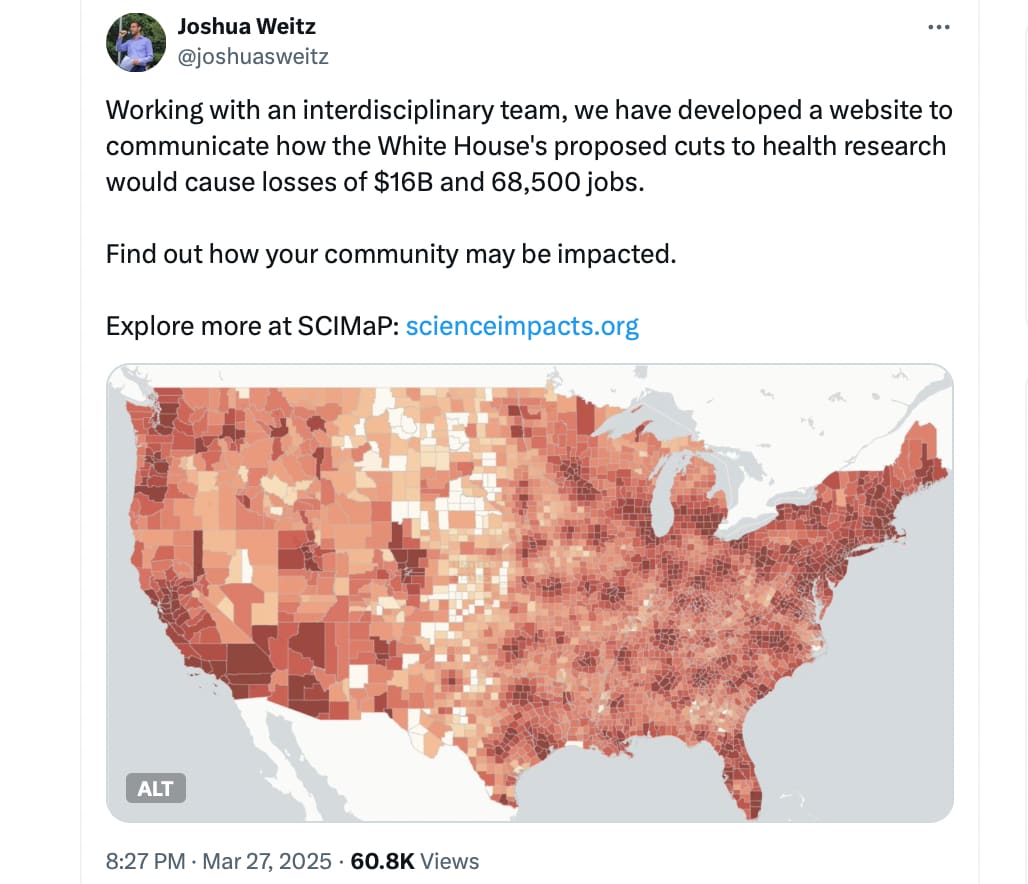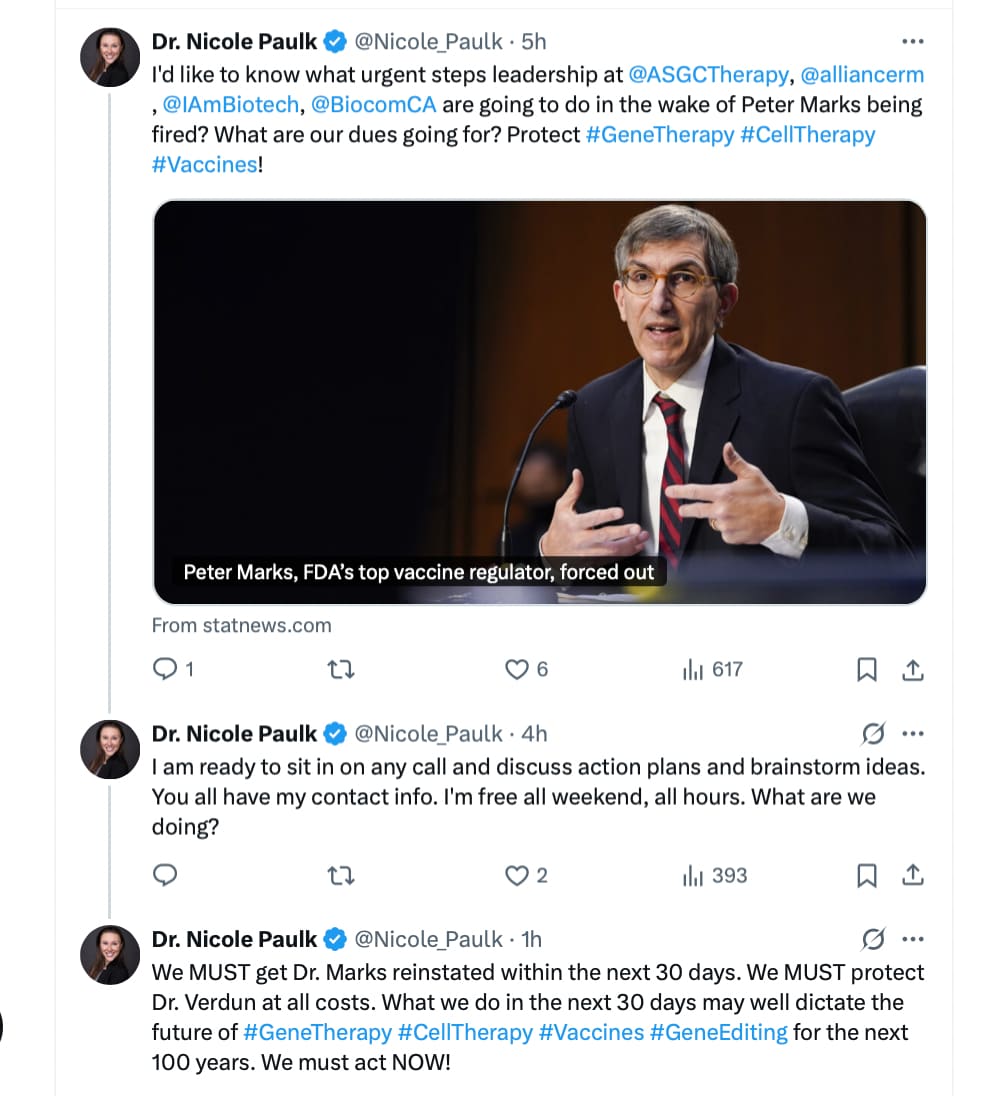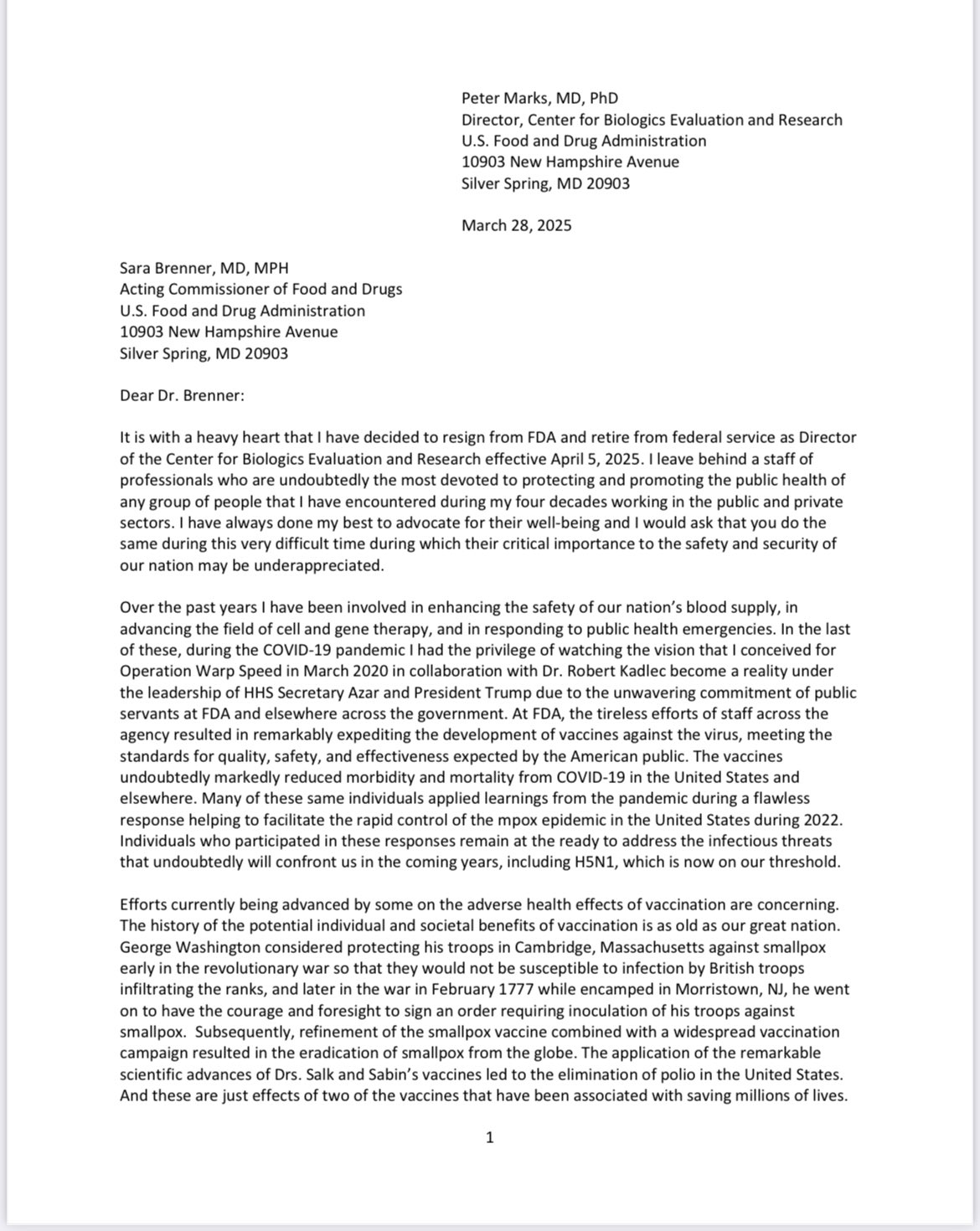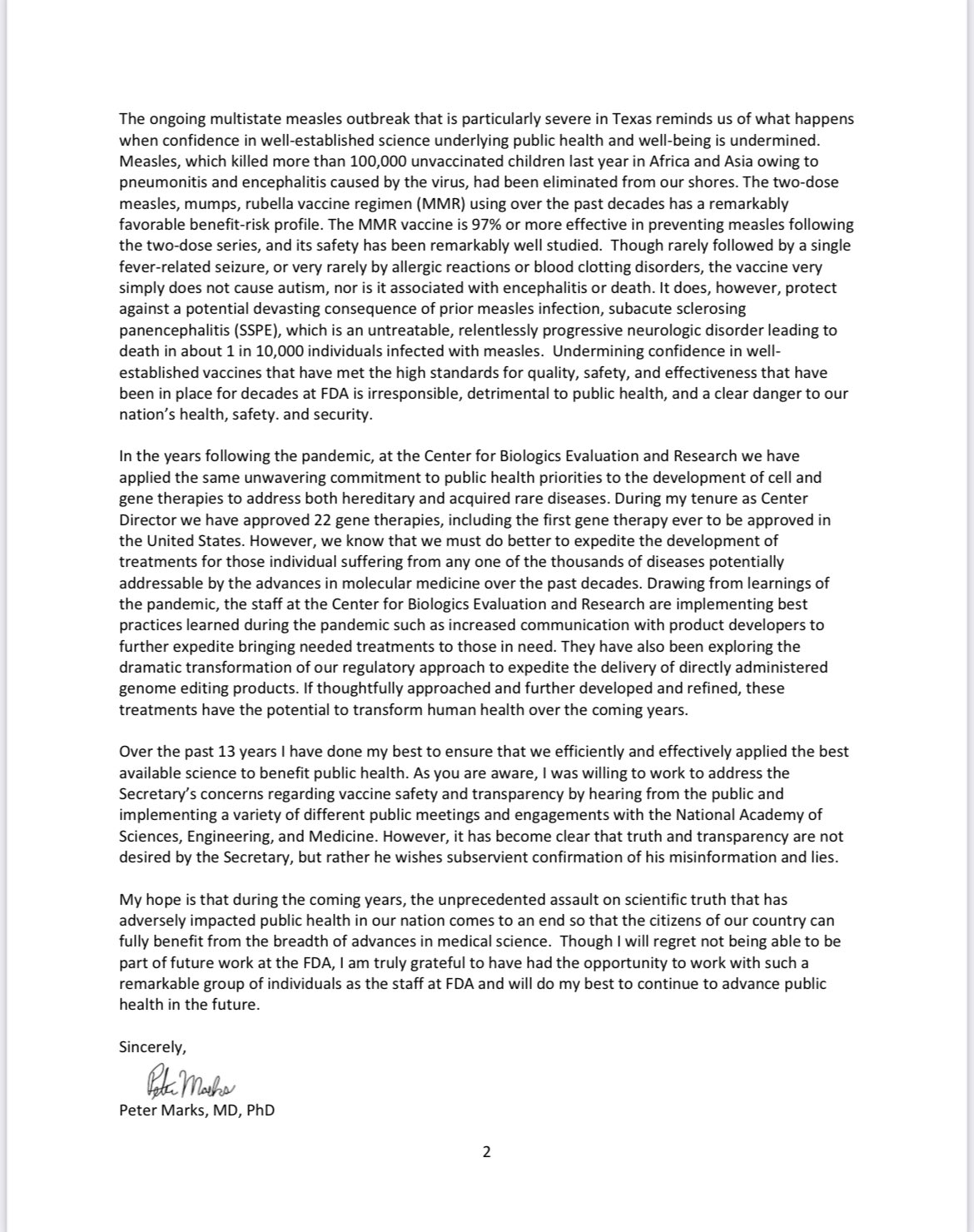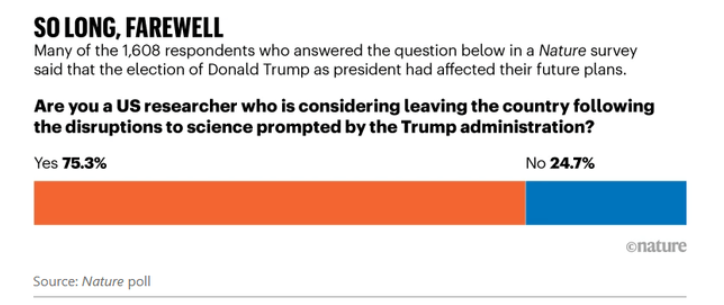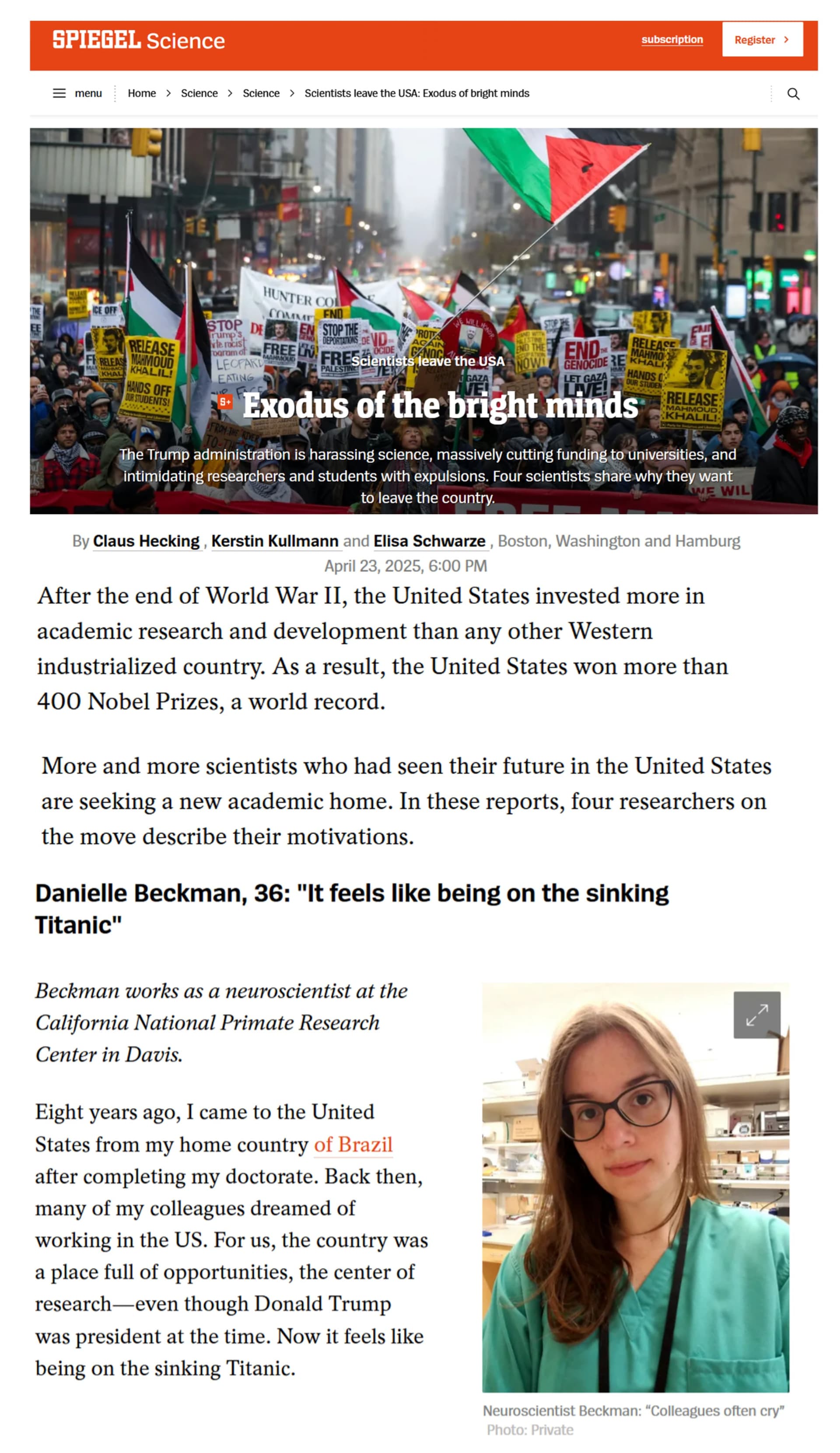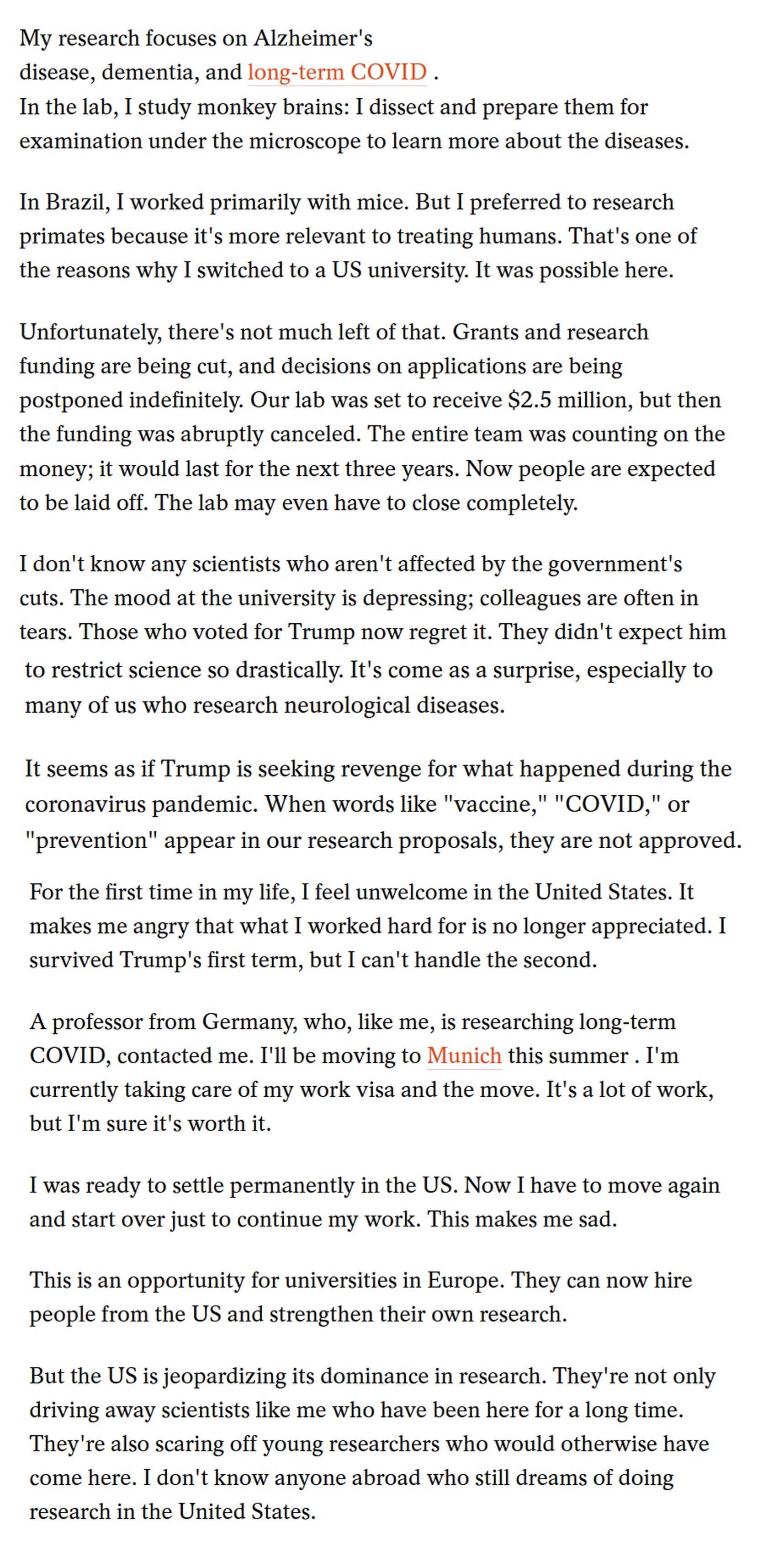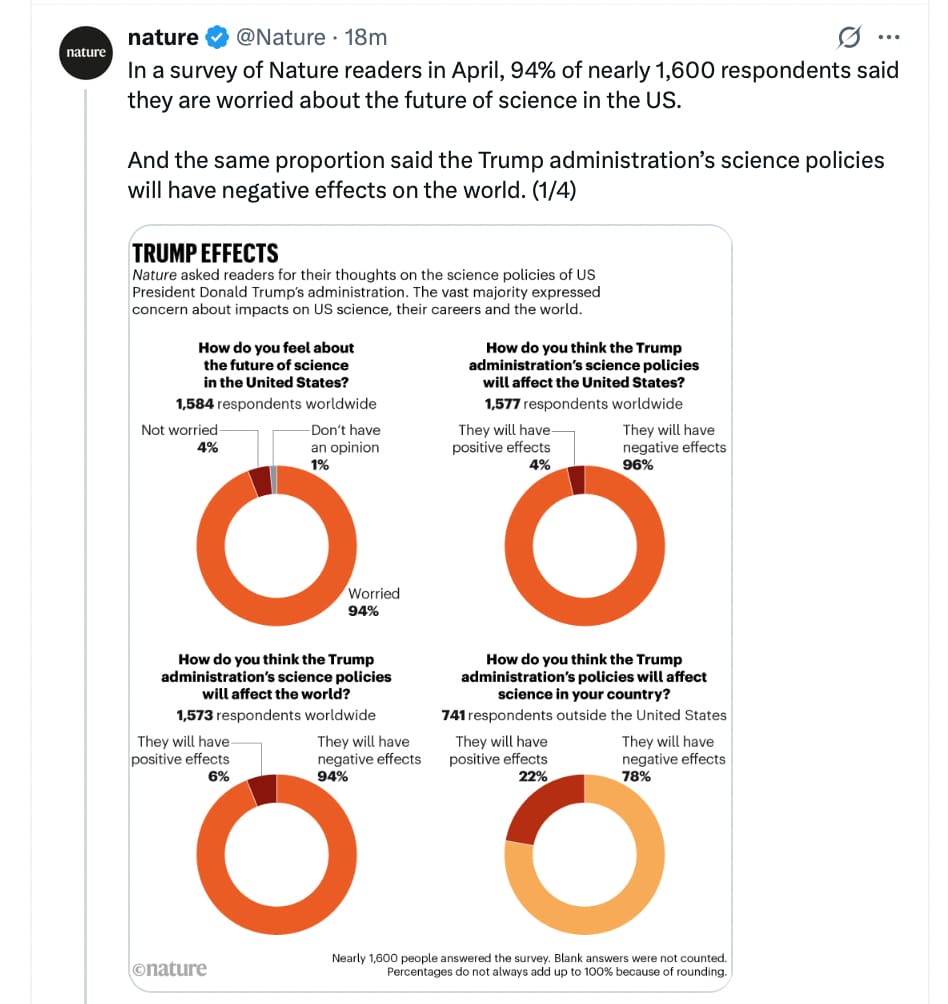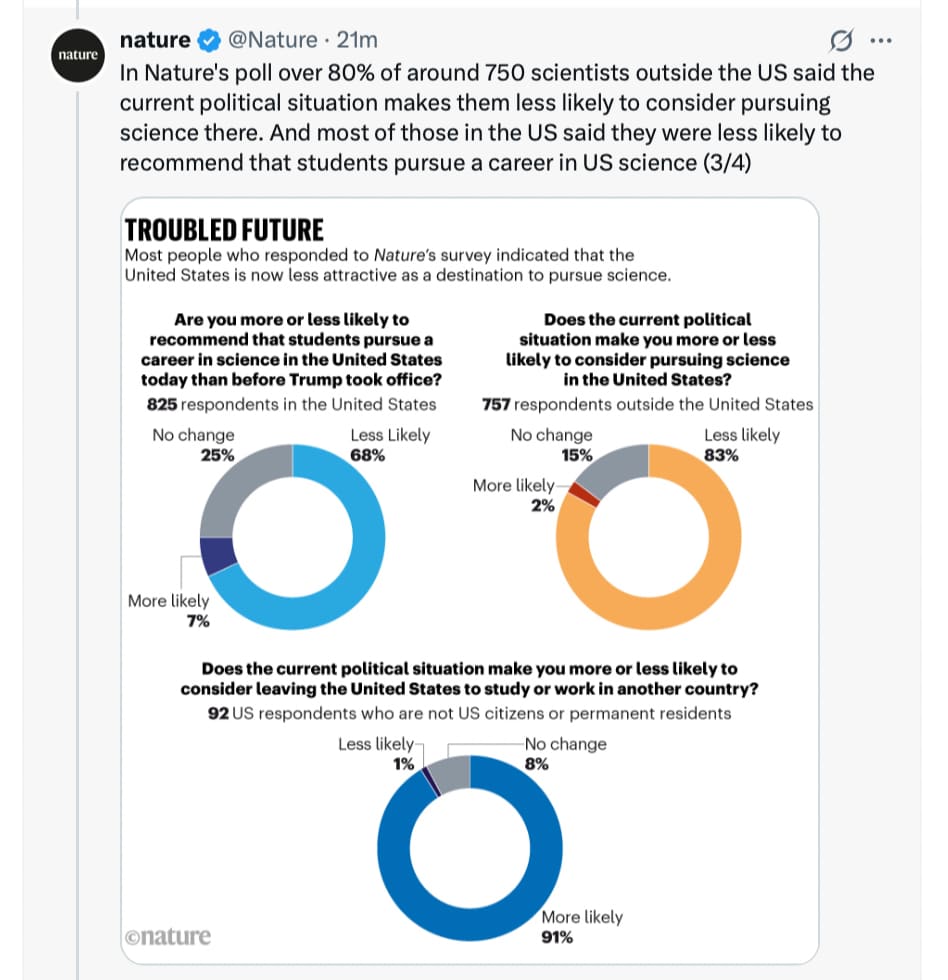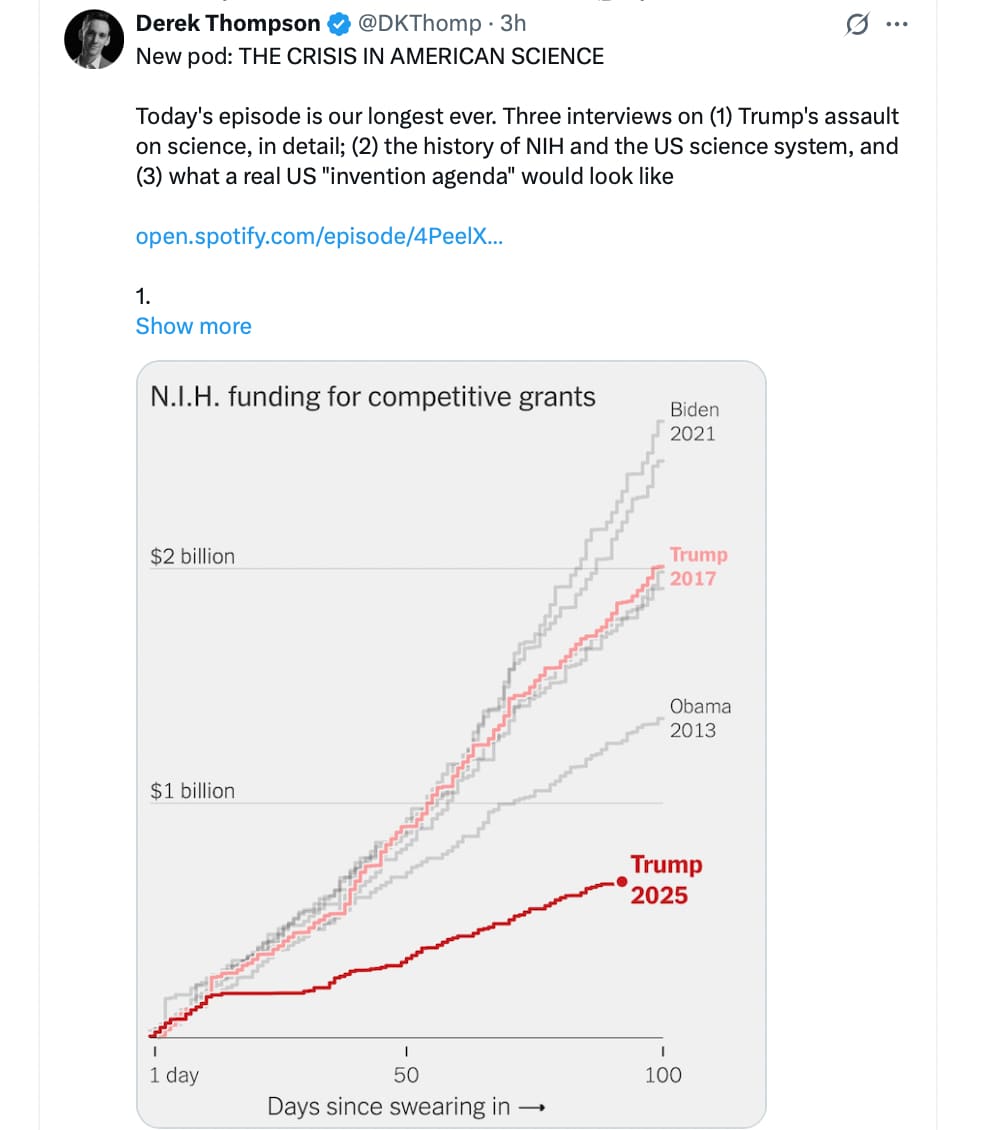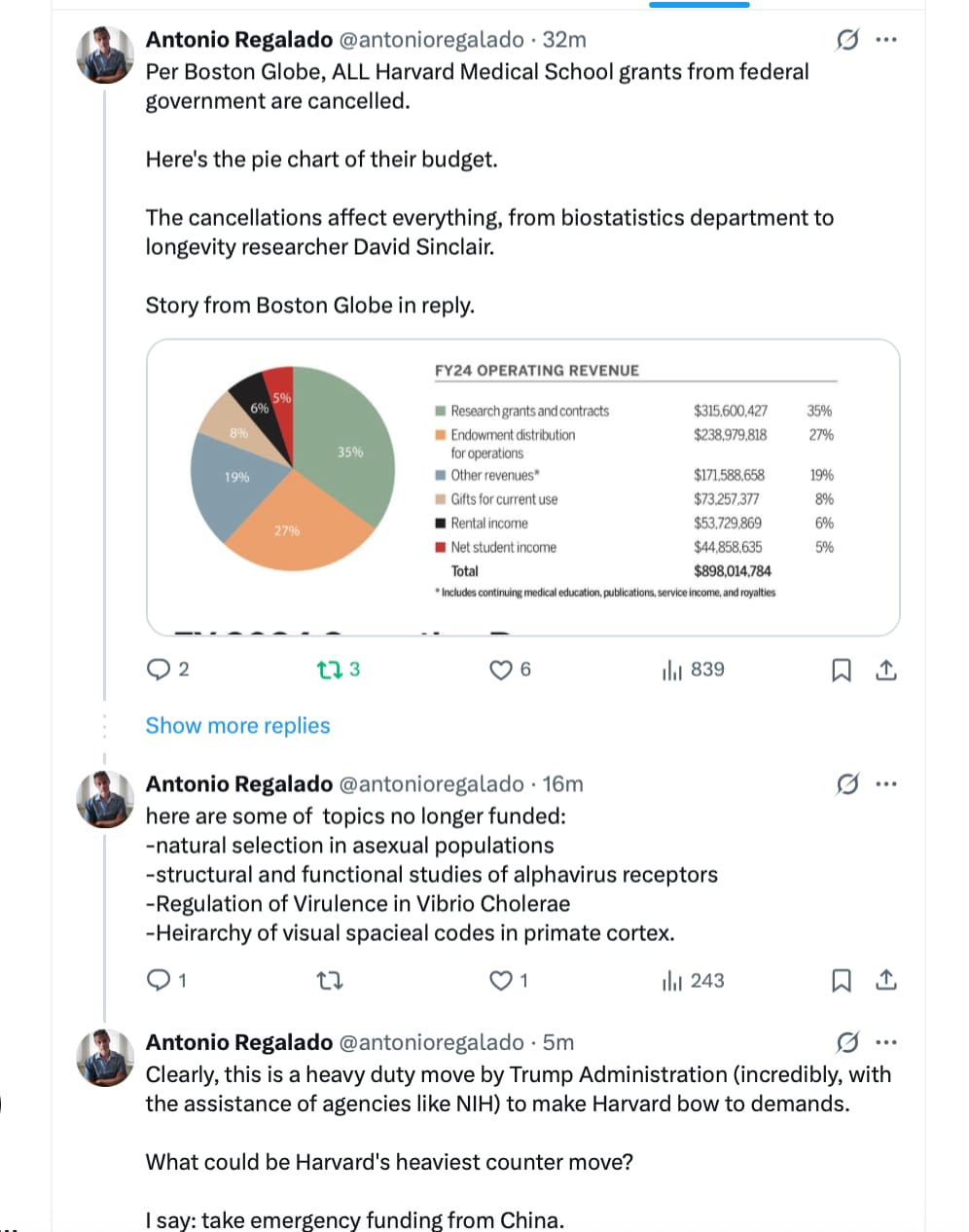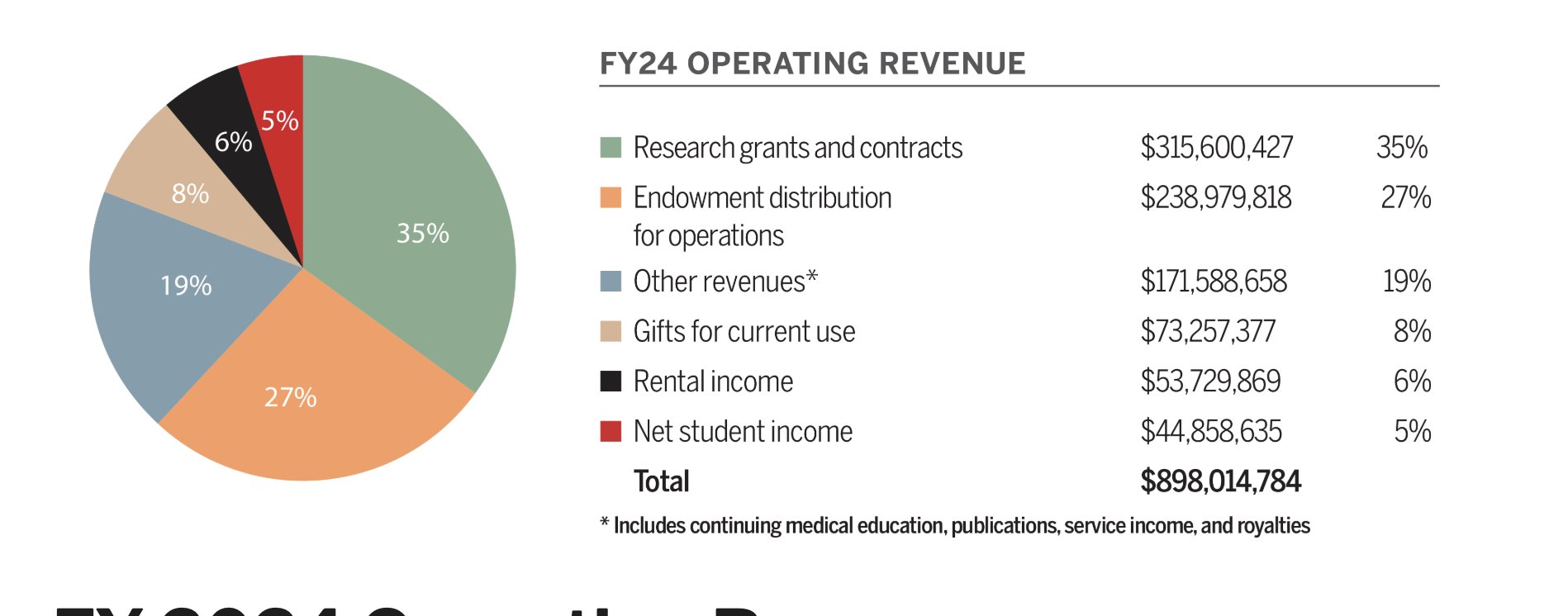This just feels wrong on so many levels. Those who do not learn from the past are doomed to repeat it.
Meanwhile, biotech leaders are extremely concerned about the gutting of the NIH of experts, and its likely impact on slowing delivery of new therapies:
Source: https://x.com/Nicole_Paulk/status/1906016132148117727
“We are deeply concerned that the loss of experienced leadership at the FDA will erode scientific standards and broadly impact the development of new, transformative therapies to fight diseases for the American people,” John Crowley, head of the biotech lobbying group BIO, said in a statement.
“Marks will be sorely missed,” John Maraganore, a biotechnology leader and former CEO of Alnylam Pharmaceuticals, wrote on X.
Marks, a physician and hematologist, has led the Center for Biologics Evaluation and Research since 2016, overseeing the agency’s review of vaccines, blood products and some genetic medicines. He helped come up with the idea for Operation Warp Speed, a cross-government initiative that helped the U.S. quickly develop, review and produce several safe and effective vaccines for COVID-19. He’s also championed the development of cell and gene therapies, pushing the agency to be more flexible and move faster — sometimes controversially so
.
It’s a new dark ages for medical research and progress. I have a feeling longevity therapies are going to be slow in coming. Europe will probably cut back as well as more money flows into the military complex.
National institute of aging decimated
https://www.splinter.com/bloodbath-at-nih-and-elsewhere-at-hhs-begins
Do we know if the ITP was spared? It’s our beacon of light in these dark ages for longevity research.
She Worked in a Harvard Lab to Reverse Aging, Until ICE Jailed Her
President Trump’s immigration crackdown ensnared Kseniia Petrova, a scientist who fled Russia after protesting its invasion of Ukraine. She fears arrest if she is deported there.
A graduate of a renowned Russian physics and technology institute, Ms. Petrova was recruited to work at a laboratory at Harvard Medical School. She was part of a team investigating how cells can rejuvenate themselves, with the goal of fending off the damage of aging.
On Feb. 16, customs officials detained her at Logan International Airport in Boston for failing to declare samples of frog embryos she had carried from France at the request of her boss at Harvard.
Such an infraction is normally considered minor, punishable with a fine of up to $500. Instead, the customs official canceled Ms. Petrova’s visa on the spot and began deportation proceedings. Then Ms. Petrova told her that she had fled Russia for political reasons and faced arrest if she returned there.
…
The Kirschner Lab, where Dr. Peshkin works, is investigating the earliest stages of cell division. These changes are easy to observe in the eggs of the xenopus frog, which are large and hardy. To lure Marc W. Kirschner to Harvard, the university constructed a vast aquarium where females bob in circulating water, known internally as the “frog palace.”
Dr. Peshkin’s team is interested in sperm and egg cells, and how they repair damage as an embryo develops. They needed someone equally fluent in machine learning and cell biology, Dr. Peshkin explained in a post on Kaggle, an online community for data scientists. Ms. Petrova reached out.
When she arrived in Boston in May 2023, Dr. Peshkin was shocked to discover that she had not brought a suitcase; she carried a backpack. It became clear, he said, that she was “extremely ascetic,” entirely wrapped up in her research.
Many in the research community there only learned about it two weeks ago, when Ms. Petrova’s co-workers started a GoFundMe appeal to help pay her legal expenses. The news sent shudders through a sprawling community of scientists who immigrated to the United States for careers in research. It comes amid deep cuts in federal funding for science that, to many, signal that a period of openness and progress may be ending.
Read the full story: https://www.nytimes.com/2025/04/11/science/russian-scientist-ice-detained-harvard.html?unlocked_article_code=1.-04.rsOe.fUKopU027aZ9&smid=url-share
Related:
GoFund Me for the Scientist:
https://www.gofundme.com/f/stand-with-kseniia-a-harvard-scientist-in-need
More on this group led by Leon Peshkin:
White House to propose massive NIH budget cut
The Washington Post is reporting that Trump’s near-final 2026 budget proposal will seek a roughly 40% cut to the current $47.4 billion budget of the National Institutes of Health. The proposal would also merge NIH’s 27 institutes and centers into eight and eliminate the nursing and minority health institutes, according to the newspaper. (The Centers for Disease Control and Prevention would be slashed 44% to $5.2 billion as part of an overall $40 billion, or one-third, cut to the budget of the Department of Health and Human Services.) Congress, which will have the final say, rejected requests Trump made during his first term to slash NIH’s budget.
DOE overhead costs cap blocked
In response to a lawsuit brought by a coalition of universities and higher education organizations, a federal judge in Massachusetts today temporarily blocked the U.S. Department of Energy from implementing its plan to cut in half the overhead rate it allows on grants to universities. The decision by District Court Judge Allison Burroughs marks the second time the courts have blocked a Trump administration effort to slash the “indirect cost” rate allowed by a major research agency; on 4 April a different federal judge prevented NIH from moving ahead with a similar plan.
On 11 April, DOE abruptly announced it would cap its indirect cost rate at 15%—meaning it would pay universities no more than an additional 15 cents for every dollar of direct research it funds. The current average is about 30%, DOE said, adding that the change would save DOE $405 million in an annual external research grants budget of $2.5 billion. (That total doesn’t include DOE’s support for its 17 national laboratories.)
University groups decried the move, arguing in a lawsuit filed on 14 April that DOE had violated a federal law that required the department to explain its justification for the cut and seek public comment. They also noted that the courts had already blocked a nearly identical effort by NIH to cut its indirect cost rate to 15%. In issuing today’s temporary restraining order, Burroughs wrote that the plaintiffs had made a compelling case that DOE’s policy would cause them “immediate and irreparable injury,” and ordered each side to prepare for a 28 April hearing on the matter.
60 minutes talks about the effects of NIH cuts.
The FDA’s Crisis Is Everyone’s Crisis
On April 1, 2025, the US Department of Health and Human Services (HHS) fired about 3500 US Food and Drug Administration (FDA) employees, nearly 20% of agency staff.1 HHS also forced out career senior leaders at the FDA, including the director of the Center for Biologics Evaluation and Research, the director of the Center for Tobacco Products, and the chief medical officer, and has suggested a dramatic reorganization of the FDA into “five shared services offices,” potentially replacing the FDA’s centers.2 This followed the February 2025 firing of roughly 700 FDA employees, including staff responsible for overseeing food and device safety (before some were called back). And these changes at the FDA come amid a long list of controversial government-wide staffing directives from the Trump administration, including instructions to implement return-to-office policies, consult the US Department of Government Efficiency (DOGE) about career appointments, and hire no more than 1 employee for every 4 that depart.3
It may be too soon to know precisely how this upheaval will affect specific FDA responsibilities and initiatives. But it is not too soon to know that the FDA is in crisis. The indiscriminate elimination of FDA staff, whether through firing, cessation of hiring, buyouts, or pushing people out, runs counter to the FDA’s many statutory obligations, including the bargains envisioned in user fee legislation. This, in turn, puts patients, consumers, clinical care, and industry at risk of needless harm. As former FDA Commissioner Robert Califf put it, “FDA as we’ve known it is finished.”1
- Science editor Holden Thorp on
- what makes the US science system special
- why private capital can’t replace the NIH/NSF
- the cost of the Trump cuts
- the mistakes of scientists under COVID
- the dangerous politicization of science under Trump
- ASU economist/historian Bhaven Sampat on
- the 200-year history of American science
- OSRD: “the most important American institution nobody has heard of”
- how WWII invented the modern innovation system
- the prescient worries of the first NIH directors
- MIT research Pierre Azoulay on
- what the NIH does well
- what the NIH doesn’t do well
- time, as the most important ingredient for scientific creativity
- a reformist invention agenda for American science
Podcast:
Even more NHI cuts this past weekend.
DOGE only goes skin deep to examine, but cuts to the bone. This makes me fear for the ITP.
Chinese people inside and outside the communist country are comparing the beginning of Donald Trump’s second administration to the so-called Cultural Revolution, the decade-long period of unrest that ushered longtime chairman of the Chinese Communist Party Mao Zedong into power nearly 60 years ago.
“Coming from an authoritarian state, we know that dictatorship is not just a system — it is, at its core, the pursuit of power,” Wang Jian, a Chinese journalist based in Japan, wrote in a since-deleted X post cited by the newspaper. “We also know that the Cultural Revolution was about dismantling institutions to expand control.”
Source: https://x.com/antonioregalado/status/1923459279417180523
Story (paywalled):
Related Reading:
Trump Admin’s $9 Billion Review of Harvard’s Grants Could Hit Boston’s Hospitals Hardest
In a move that attracted international attention, the White House threatened to strip Harvard University of US$2 billion (£1.5 billion) in federal funding, potentially revoke its tax-exempt status and even prevent it from enrolling international students if it didn’t capitulate to a new list of demands.
The five-page ultimatum reads like a political ransom note. It calls on Harvard to make major “governance reform” including enforcing “viewpoint diversity” in admissions and hiring, squashing diversity, equity and inclusion (DEI) initiatives, and more screening of foreign student applicants for their beliefs and reporting those who commit “conduct violations” to authorities.
It’s hard to overstate the backlash. Princeton president Christopher Eisgruber has called Trump’s latest moves “the greatest threat to American universities since the Red Scare of the 1950s”. Political analyst Fareed Zakaria believes that the Trump White House is waging a version of Mao Zedong’s Cultural Revolution, when the Chinese leader took control of China’s leading universities.
“No government — regardless of which party is in power — should dictate what private universities can teach, whom they can admit and hire, and which areas of study and inquiry they can pursue,” said Harvard president Alan Garber.
The clash between Harvard and the White House is laying the groundwork for a high-stakes showdown, pitting academia’s defenders against the Magaverse. Yet it’s possible to believe two things at once: that universities do suffer from some, even many, of the ailments that Trump has alleged; and that Trump’s onslaught against higher education is strategically misguided, politically motivated and aimed at putting universities under the president’s thumb.
To be fair, this isn’t the same as the Cultural Revolution of China. Family and friends turned against each other and reported people who were against the government for arrest or execution. It was a time of fear and brutality. It traumatized a generation.
My wife’s grandfather was a wealthy businessman and landowner at the time. He had everything taken from him and barely escaped with his life. The stress and anxiety were too much, though, and he died within a year.
Members of the CCP arrested him, handcuffed and blindfolded him, and drove him to a place in the middle of nowhere. When they arrived and took off his blindfold, he was standing at the edge of a pit where many of his fellow businessmen and friends were lying dead at the bottom. With a gun to his back, he was told to give his business and land to the CCP or end up at the bottom of the pit.
This is not the Cultural Revolution. However, it does have some similarities in the weakening of governmental institutions, and it is not a good place for the USA to be.
